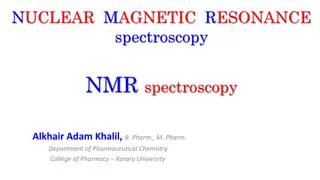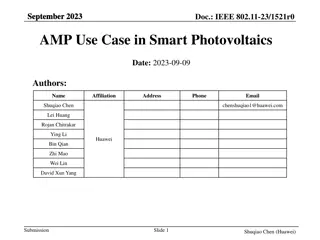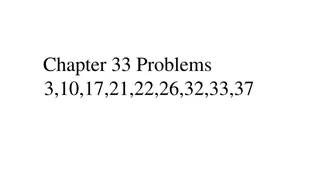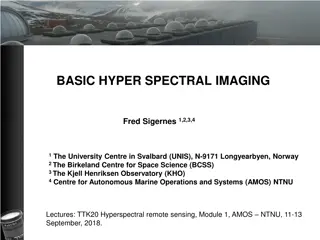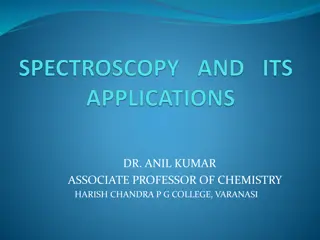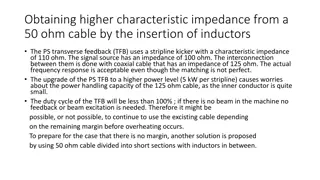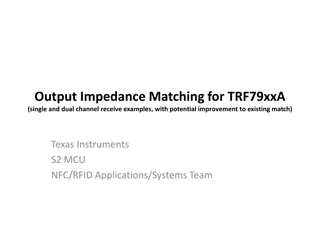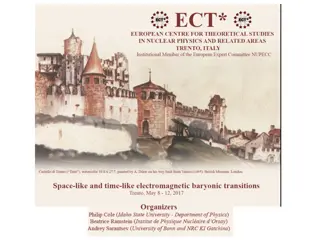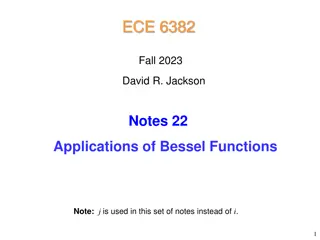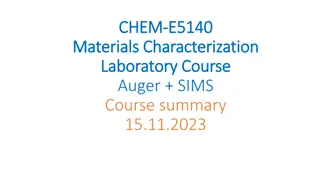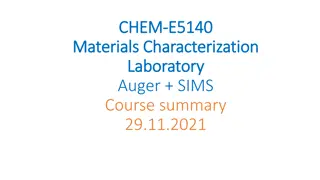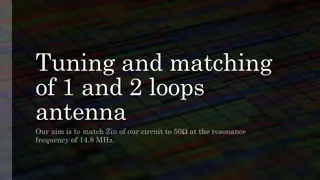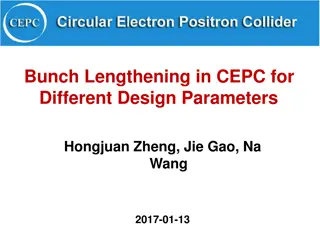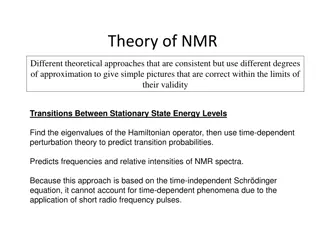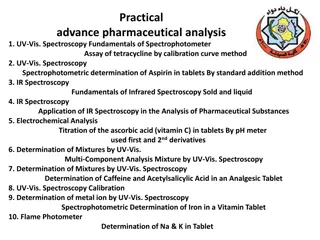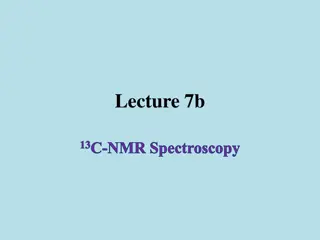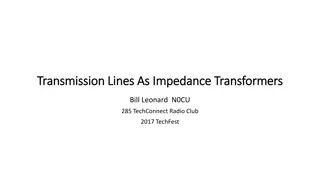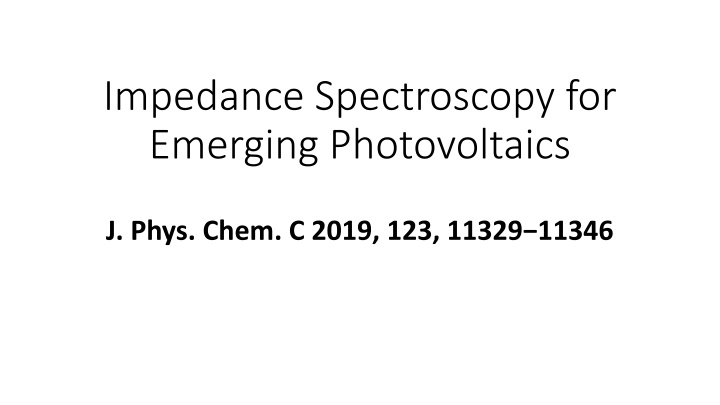
Impedance Spectroscopy for Photovoltaics Insight
Immittance spectroscopy techniques such as impedance, admittance, capacitance, and dielectric spectroscopies are utilized to understand physical and chemical properties of materials and devices. These methods measure the sample's response to an electric field and the energy storage vs. dissipation as a function of frequency, revealing relaxation time scales and identifying various processes at different time scales in semiconductors and electrochemical cells. Frequency-dependent permittivity spectra indicate electrical and ionic transport mechanisms, offering insights into the behavior of materials under different conditions.
Download Presentation

Please find below an Image/Link to download the presentation.
The content on the website is provided AS IS for your information and personal use only. It may not be sold, licensed, or shared on other websites without obtaining consent from the author. If you encounter any issues during the download, it is possible that the publisher has removed the file from their server.
You are allowed to download the files provided on this website for personal or commercial use, subject to the condition that they are used lawfully. All files are the property of their respective owners.
The content on the website is provided AS IS for your information and personal use only. It may not be sold, licensed, or shared on other websites without obtaining consent from the author.
E N D
Presentation Transcript
Impedance Spectroscopy for Emerging Photovoltaics J. Phys. Chem. C 2019, 123, 11329 11346
The immittance spectroscopy refers to a class of techniques, including impedance, admittance, capacitance, and dielectric spectroscopies, that are applied to gain insight into the physical and chemical properties of materials, interfaces, and multijunction devices, often as a function of applied voltage, illumination, temperature, or evironmental stress
During an immittance measurement, the response of a sample to a time-varying electric field is monitored, and the fraction of electrical energy that is stored versus the fraction of energy dissipated by the sample, as well as the relaxation time scale (the time that it takes the sample to return to equilibrium after excitation by the input), is measured as a function of frequency
Figure 1 shows examples of the range of time scales, and the corresponding frequencies, of common relaxation processes in semiconductors and electrochemical cells. At very fast time scales (e.g., femtoseconds) changes in the permittivity spectrum due to electronic transitions can be studied with transient optical spectroscopy. At slower time scales (nanoseconds), molecular or lattice polarization, as well as dipolar rearrangement, may be observed with dielectric spectroscopy. Electronic and ionic conduction can be investigated with electrical spectroscopy at slower time scales (microseconds and slower).
These relaxation events result in a frequency-dependent permittivity spectrum. Permittivity is a material parameter that depends on temperature and frequency of the time-varying electric field but not on the electric field strength. In the static case, the permittivity reduces to the dielectric constant. An ideal dielectric (stores electrical energy) has a frequency- independent permittivity, while the permittivity of an ideal conductor (dissipates electrical energy) drops linearly with increasing frequency. The permittivity spectra of semiconductors and electrochemical cells contain frequency- dependent features reflecting processes such as electrical and ionic transport and dipole alignment
Theoretically, varying the frequency of the input signal over an infinite range would make it possible to probe all possible relaxation processes in a sample with a single measurement. Technically and practically, however, experimental equipment for performing immittance measurements is limited to smaller frequency ranges. The term immittance spectroscopy was originally coined to describe electrical spectroscopy (impedance and admittance), which is performed between subhertz and megahertz and is used to study the resistive and capacitive properties of solid-state devices and electrochemical cells
s. Electrical immittance spectroscopy is useful to study electrical and ionic conduction, and slow (microseconds to seconds) charge transfer processes at material interfaces. The term dielectric spectroscopy generally refers to higher frequency measurements, megahertz to gigahertz, applied to probe the structural properties of materials, usually dielectrics. Terahertz spectroscopy is an optical spectroscopic technique that applies ultrafast optical signals to probe relaxation processes in the terahertz range and is not historically included in the class of immittance spectroscopies; however, the approach is analogous
Experimental Design. Impedance spectroscopy is a powerful diagnostic tool for the in situ monitoring of transport and recombination processes at different points along the solar cell current voltage (IV) curve, investigating device aging and performance loss as the result of external stress factors, as well as identifying how variations in fabrication protocols influence solar cell parameters. However, a single impedance spectrum generally will yield no useful information. Therefore, to obtain useful insights, it is best practice to perform impedance spectroscopy as a function of an experimental parameter of interest, such as dc voltage, illumination conditions, temperature, the thickness of the solar cell active layer or transport layers, variation of contact materials, or as a tool to diagnose performance loss during aging tests. This will facilitate the interpretation of the spectra, and extraction of relevant physical parameters from the data
Data Integrity. A prerequisite for the reliable analysis of impedance spectra is to ensure that there are no artifacts in the spectrum. This is not always an obvious or nontrivial task, as the source of artifacts ranges and also depends on the specific measurement setup, dc offset, illumination conditions, and the sample. The most common artifacts are due to a nonlinear sample response, inductance from long cables, irreversible changes to the sample during the measurement, and noise. Good practice is to check the compliance of the impedance spectra to the Kramers Kronig relations (section 4.5 and section 5.1) for each measurement, and if necessary, modify the measurement procedure to remove any external sources of error
Data Analysis. The most widely applied approaches to analyze impedance data from solar cells are equivalent circuit modeling and capacitance frequency modeling. Equivalent circuit modeling (section 5) is a relatively quick strategy to describe the global sample response by quantifying the resistive and capacitive contributions to the impedance spectrum over the full frequency range of the measurement. To yield meaningful results, however, the circuit model must be based on the underlying physical parameters of the device. In the photovoltaic community, equivalent circuit models have been developed to describe the physical processes of carrier diffusion and recombination in the illuminated device
In these models, transport and recombination are considered as two independent relaxation processes occurring on distinct time scales, and carrier recombination is assumed to be a first-order, nonreversible reaction. This approach requires that both relaxation processes occur on time scales within the frequency window of the impedance measurement, i.e., microseconds (megahertz) to seconds (hertz). This is the case for electrochemical DSSC devices that are characterized by long carrier lifetimes (microseconds to milliseconds)8 12 and OPV devices based on organic semiconductors with low carrier mobilities (10 7 to 1 (V s)/cm 2 ), as transport and recombination processes are sufficiently slow that they can be observed with an impedance measurement and therefore modeled with an equivalent circuit

